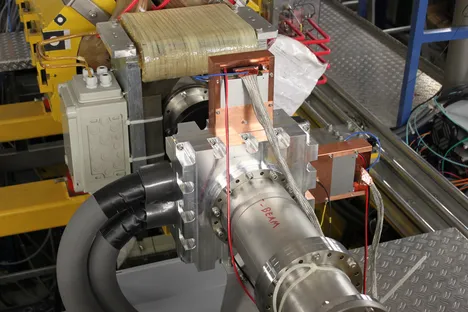CERBEROS: a pion beam tracker in HADES
The successful experimental campaigns of the HADES detector located at the SIS18 of the GSI in Darmstadt, Germany, with proton and heavy ion beams have been enlarged with secondary pion beams. Such secondary beams are produced by a high intensity Nitrogen beam (dN/dt > 1011 ions/spill) impinging on a Beryllium target leading to a huge spread of momentum and position only limited by the intrinsic beamline acceptance of around ∆p/p ≈ 8%. To meet the demand of later on performed exclusive analysis of investigated reactions (e.g. ) it is mandatory to know the initial pion momentum event by event with a resolution below 0.5%. Therefore, we developed in our group CERBEROS (CEntRal BEam TRacker for PiOnS) (for more details link: “J. Adamczweski-Much et al., Eur. Phys. J A53, 188 (2017)”), a secondary beam diagnostic system, to allow for on-line beam monitoring as well as the momentum reconstruction of each individual pion at high beam rates (dN/dt > 106 part./s).


CERBEROS consists of two tracking stations located along the pion beam chicane following the pion production target (C1 and C2, see picture above). Two double-sided silicon strip detectors (10x10 cm2) with minimal multiple scattering and sufficient spatial resolution of every pion hit are employed, since the momentum reconstruction is achieved on the basis of the four extracted hit positions and the beam optics transport calculations. The readout is realized with four self-triggered n-XYTER ASIC chips. Due to the self-triggering architecture and local storage capability, the chips enable on-line tracking of each traversing pion. Moreover, events in the first and second detector as well as events in the HADES detector can be correlated with help of the provided time information. The readout chain is completed by the TRB3, allowing the integration of secondary beam tracker into the HADES data acquisition system as well as the operation as a stand-alone system.